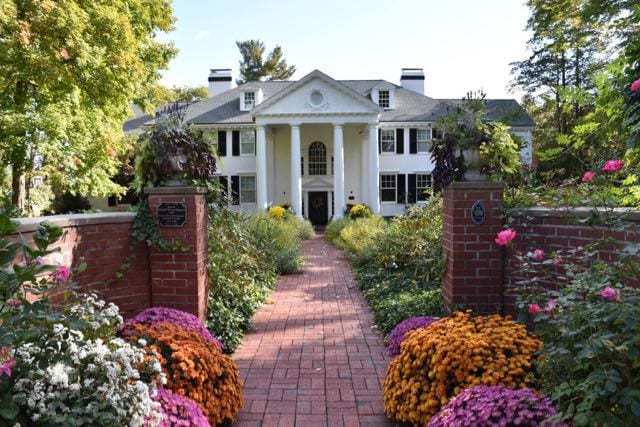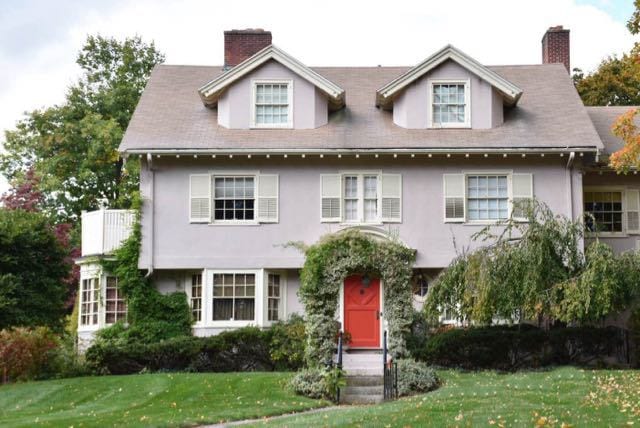One Street, Two Connecticut Cities and Eight Special Old Homes

Audio By Carbonatix

Eyrie Knoll, on the West Hartford side of Prospect, built in a Colonial Revival style. Photo credit: Deb Cohen
Deb Cohen takes a walking tour of the beautiful homes along Prospect Avenue in West Hartford and Hartford.

Prospect Avenue home. Photo credit: Deb Cohen
By Deb Cohen
One street and two cities, you say? No doubt it’s unusual but in this case it’s true. I recently took a fascinating walking tour of Prospect Avenue with Mary Falvey from Hartford Preservation Alliance and Mary Donohue of Connecticut Explored where I learned a bit of old home and architectural history.
The middle of Prospect Avenue is the town line between Hartford and West Hartford. It is also the centerpiece of the Prospect Avenue Historic District, which covers 300 acres and includes about 240 contributing historic homes (that’s over 80 percent of the total number of homes!)

The Beatrice Fox Auerbach House. Beatrice was President of G. Fox & Co. in Hartford, a Connecticut institution for decades. Photo credit: Deb Cohen
The homes in the Prospect Avenue Historic District were primarily developed from 1895 to 1945 by the elite from Hartford that originally lived on such city streets as Farmington Avenue, Asylum Avenue and Washington Street.
When Hartford real estate increased in value many wealthy home owners decided to sell their estates and rebuild in what was then called the Prospect Hill area. In this way they were also able to modernize their homes for the latest improvements as well.
Their previous estates in Hartford were torn down in most cases to make way for apartment buildings and other infrastructure for the growing city.

A stunning view of the Hartford skyline from Prospect Avenue. Photo credit: Deb Cohen
The Prospect Hill area was chosen for its spectacular view of Hartford which remains spectacular today. It’s said that Beatrice Fox Auerbach, the President of G. Fox & Co., America’s largest privately owned department store for decades, could see the storefront from her backyard.
Sadly, G. Fox is gone but the iconic building designed by New York architect Cass Gilbert remains. I have fond memories of visiting Santa Claus there on the top floor when I was a child.
The majority of homes in the district are architect designed which makes each one unique. There are a number of Georgian Revival, Tudor Revival and Colonial Revival homes but each has special details which distinguish them from their neighbors.

This unique mansion, with an entry bridge leading to the front door, is near the highest point in Hartford. Photo credit: Deb Cohen
The house at 1144 Prospect Ave., featured above, was built in 1912 and designed by Smith & Bassette. Its current homeowners received an award from the Hartford Preservation Alliance for the restoration work performed, and it has been featured on the Annual Holiday House Tour by the Mark Twain House.
I toured the home during the holidays last year and I can assure you the honor is well deserved!
The home was owned by Harriet Hansel, wife of Charles Hansel of Hansel Jewelry. The deed was in her name which is unusual for the era, indicating that perhaps things weren’t quite right between Harriet and Charles. Records show that Charles wasn’t listed as a resident in the 1920s, and in 1925 records showed he lived in a boarding house on Laurel Street in Hartford. The scandal!

Originally the Wadsworth Tavern, this is the oldest home on Prospect Avenue. Photo credit: Deb Cohen
1234 Prospect Ave., a Federal style home, is on the corner of Prospect and Albany Avenue but it originally faced Albany Avenue. It was the Wadsworth Tavern, built in 1828, and it served as a resting point for those traveling via stagecoach on Albany Turnpike to Albany, NY.
In 1919 the building was turned to face Prospect and after some major flooding due to burst pipes it was abandoned for a long period of time. Thankfully it has since been renovated and is a private residence.
By the way, the original Wadsworth Tavern sign can be found at the Connecticut Historical Society which has the most impressive collection of old tavern signs in the country.

Eyrie Knoll, on the West Hartford side of Prospect, built in a Colonial Revival style. Photo credit: Deb Cohen

A close up view of one of two eagles guarding the entrance to Eyrie Knoll. Photo credit: Deb Cohen
Eyrie Knoll, pictured above, at 1093 Prospect Ave. was built in 1929 by owner Charles Cooley, the President of Society for Savings in Hartford. Before moving to Prospect Hill, he lived on the site of the current Aetna Life & Casualty Insurance Company on Farmington Avenue.
The home was designed by architect Grosvenor Atterbury and is a mixture of Colonial and Tudor Revival elements with a Colonial Williamsburg feel. Atterbury studied at Yale and Columbia and was well-known for designing country houses for major industrialists of the era.
Learn more about the current owners and their incredible art collection in a recent article from the Hartford Courant.

Lovely Arts & Crafts style home. That red door is so cheery! Photo credit: Deb Cohen
This Arts & Crafts home is rather unique in the district, and one individual on our tour commented that it seemed much more livable. In fact, that’s exactly what the homeowner had in mind when it was built. The Arts & Crafts style was intended to be more comfortable and cozy.
James P. Andrews, a court reporter, originally inhabited this home. It’s hard to imagine a court reporter of today affording a home like this, but at that time the role was defined differently and was considered a plum assignment.

Tudor Revival home with unusual stonework on the facade and a slate roof. Photo credit: Deb Cohen
The entire neighborhood recalls an era when wealth could be amassed by manufacturing things. In fact, the current day Governor’s mansion (also on Prospect Avenue) was originally built with the fortunes of the Capewell Horse Nail Company in Hartford.
That’s right … those little nails that attach horseshoes to horse hooves made Hartford the Horse Nail Capitol of the world.
Another home was built by Alfred Fuller of Fuller Brush company fame. Those door to door brush sales really raked in the bucks! Yet another was built off of the profits of electric switches and another off of brass fittings.

The fall foliage frames the doorway of this home perfectly. Photo credit: Deb Cohen

Detail of the entryway includes dentil trim and leaded windows. Photo credit: Deb Cohen
The integrity of the architecture in the Prospect Avenue Historic District is outstanding. Almost all of the original homes are still standing and their architectural features have been well maintained. The entire district is on the National and State Registers of Historic Places.
However, the Hartford portion of the district is more heavily protected by preservation ordinance. Hartford has adopted legislation which protects any home with the National or State Register designation from demolition, while West Hartford has no regulations in place to protect these homes from demolition or major alteration.

Colonial Revival with a Neoclassical twist built by the CEO of American Mutual Insurance Co. Photo credit: Deb Cohen
The desirability of the neighborhood was further enhanced by Elizabeth Park which opened to the public in 1897 and by the Hartford Golf Club which was organized in 1896. Elizabeth Park is on the National Register of Historic Places (as is the Hartford Golf Club District) and is known for its incredible rose garden, the first to be open to the public in 1904.
Thanks to both Mary and Mary for the informative and insightful tour of these old Connecticut homes! Keep an eye out for other walking tours sponsored by the Hartford Preservation Alliance, or take a stroll on your own through the Prospect Avenue Historic District.
Make it a day to remember with lunch at the Pond House Cafe in Elizabeth Park, a highly recommended West Hartford dining destination. And remember … you don’t have to travel far to travel!
Deb Cohen of West Hartford started The Front Door Project in the summer of 2014 as a way to motivate herself to get outside, exercise and pay more attention to her surroundings. She began photographing homes with a primary focus on the front door, which is a welcoming focal point. Social media provided the means to share the photographs and a ready audience to follow along, and her new-found interest soon led to exploring other local area towns in my free time. The “project” has led to deeper interests in architecture, local history and historic preservation and came at a time in Deb’s life when she needed some inspiration. Please join Deb as she continues to share her everyday travels and explorations of other towns and places! You can find her other posts at www.thefrontdoorproject.com.



